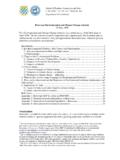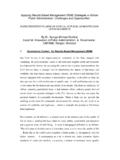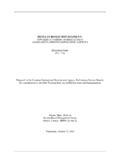Transcription of Managing for Results - Sida
1 Managing for Results A Handbook on Results - based management for Sida Research Cooperation December 2014 Associates for International management Services 2 Table of Contents Introduction .. 3 Section II: Programme 11 A. What s the Problem? .. 11 B. What are Results ? .. 13 C. Objectives .. 16 D. Outcomes .. 17 E. Outputs .. 20 F. Performance Indicators .. 21 G. Data Collection Strategy .. 24 H. Assumptions and Risk Analysis .. 24 Section III: Programme Implementation: Monitoring and Reporting .. 28 A. Collecting Data .. 29 Planning for data collection: .. 29 Implementing data collection activities: .. 29 Reporting and using data collected: How is it going to be used and reported?
2 31 B. Assessing Progress .. 33 C. Reporting Results .. 34 Section IV: Programme Evaluation: .. 40 A. Planning the Evaluation .. 48 B. Conducting an Evaluation .. 49 C. Reporting Evaluation Results .. 50 D. Post Evaluation Follow-up Action Plan .. 52 ANNEXES .. 55 Annex A: GLOSSARY of TERMS .. 55 Annex B: TEMPLATES, FORMS AND OTHER TOOLS .. 58 1. Suggested Results - based management Logical Framework Template .. 62 2. Data Collection Strategy Worksheet .. 65 3. Suggested Annual Report Structure .. 66 4. Field Visit Data Collection Recording Worksheet .. 69 Annex C. EXERCISES .. 70 1. Exercises Section II - Programme Planning .. 70 2. Exercises: Section III: Programme Implementation: Monitoring & Reporting.
3 73 3. Exercises: Section IV: Programme Evaluation: Assessing and Evaluating Programme Results .. 74 3 Introduction Purpose of the Handbook Managing for Results is a handbook on Results based management tailored to fit the needs of Sida s research cooperation partners. The approach in this handbook is in line with a broader view of RBM as a management tool, and is aligned with OECD/DAC terminology and practices. The RBM Handbook provides how-to instructions that can be used by Sida-supported research partners for reference and as a complementary resource to RBM workshops. The handbook also can be used independently as a stand-alone source for those who have not attended a RBM training workshop or seminar but are willing to embark on their own RBM initiatives.
4 Content of Handbook After an Overview, each of the three phases of the RBM process is described: Programme Planning, Monitoring and Reporting of Programme Implementation, and Evaluation (including Self-Assessment). The handbook includes a series of exercises1 that allow the reader to practice and apply what is being learnt and that are followed by checklists against which the exercises can be compared and assessed. After reading the handbook and completing the exercises, you will have a good understanding of: What RBM is and how it can help you Key concepts and terminology Process and sequence Specific phases of RBM approach Tools for use in applying RBM approach Structure The book is divided into 4 sections that are easy to read and understand as well as several Annexes.
5 Section I: Overview The first section, the Overview, provides an understanding of the basics of the Results - based management (RBM) approach. It includes why RBM is important in research management today. The section concludes, with examples, on how RBM can be used as a management tool. Section II: Programme Planning This section introduces key RBM concepts and shows how to apply them in developing a plan for a programme. This section emphasizes the role of the RBM logical framework as an essential tool for other planning activities, citing examples. It addresses such issues as: 1 If at all possible, do the exercises with colleagues in the same project or programme, otherwise do them yourself.
6 4 What is the problem? What are the dimensions of the problem? What are its causes? How is the problem to be addressed and solved by the research entity? What does it mean to identify linkages? How can you identify alternative solutions and plan towards achieving them? What are the basic elements in RBM planning? How do you formulate objectives, outcomes, and the outputs to produce them? How do you know they are valid and how can you measure them to determine whether they can be achieved? How can you connect outputs with outcomes? Section III: Monitoring and Reporting of Programme Implementation In RBM monitoring and reporting the primary focus is on outputs and outcomes.
7 Monitoring progress in obtaining Results is an ongoing activity and is essential to assessing whether the Results you want to achieve are on course for being achieved. The section emphasizes the role of the RBM logframe as an essential tool for tracking and reporting Results . This section explains, with examples, the importance of data collection for monitoring and reporting while also showing the different sources of data and how to collect them, and gives suggestions, with examples, for annual progress reporting. It includes: Monitoring (Data Collection) including sources and methods of data collection Assessing progress Reporting progress on annual basis.
8 Section IV: Evaluation (including Self-Assessment) The final section, Evaluation (including Self-Assessment), explains the role of evaluation in assessing Results . It addresses such issues as: Why is it important to evaluate how you are doing? What are funding sources expecting before they continue to fund you? The role of evaluation in reassuring funding sources and in identifying lessons learned is clarified. This section includes: Explanation of how to use an RBM logframe as an analytical tool to conduct self-assessment or independent evaluation of programme Results over time Planning and designing an evaluation Identifying data gaps summative (what happened) and formative (why it did or didn t happen) information Reporting evaluation Results Follow-up to Evaluation (Adjustments based on evaluation) In each of the sections, the RBM Handbook includes cross-references to material in the Annex which allows more in-depth guidance for those seeking greater detail.
9 Examples from the documents of a regional research network are included as well as from the RBM process at the global and national levels. Annexes supporting the text include: A. Glossary of terms and definitions B. Formats and Tools, with accompanying guidance. It includes: 5 a) Critical questions to ask in developing an RBM Logical framework to help you get started, and b) Examples of completed RBM Logical Framework C. Exercises and worksheets a) how to build a logical framework, including a blank Logical Framework to be filled by participants, b) how to prepare for annual reporting, and c) how to prepare for a Programme Evaluation or self-assessment.
10 Let s begin 6 Section I: Overview Results - based management What is Results - based management ? Public institutions - whether at the local, national or international level - are established to help solve problems that cannot be solved by the magic of the marketplace. These organizations are judged not by what they do, but by what they make happen. In short, they are accountable for Results . Since 1975, Sweden has undertaken research cooperation to support the development of low income countries. In 2008, Sida instituted RBM in all funded research cooperation programmes2 allowing it to demonstrate more clearly that Swedish supported research cooperation provides opportunities for utilizing research as a tool for development.




